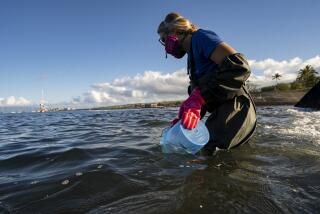Scientists Probe Death of Florida Coral Reefs
- Share via
FORT PIERCE, Fla. — Some scientists hypothesize that nitrogen flowing into Florida Bay from the Everglades is quickly killing once-vibrant coral reefs far to the south in the Florida Keys.
Others say sewage and nutrients created by man and flowing from the Keys into the ocean are to blame for the dying of the underwater world, the only living shallow-water reef system off the continental United States.
Damage to coral caused by overfishing and divers, global warming, disease, coral bleaching and coastal development might also be factors in the wrecking of the reef.
Scientists are just beginning to try to understand what is causing biological changes in this underwater home to fish, grasses, sponges and multiple other forms of sea life, but there’s no consensus yet.
“Everyone is right. Everyone is wrong,” said Ron Jones, director of the Southeast Environmental Research Center at Florida International University. “We are just now really sort of at an infancy, if you will, in determining what the causes are.”
Coral reefs consist of thousands of small organisms and cover more than 6,500 square miles of ocean in Florida, the Caribbean and the Pacific. Many scientists agree that in recent years reefs worldwide have suffered a 10% loss in coral.
The reasons vary. In Hawaii, scientists blamed badly sedimented reefs at Kahoolawe on soil erosion on the mainland. After goats eating grasses on the coastline were removed, the reefs began to recover.
In Australia, scientists believe global warming caused devastation to the Great Barrier Reef in 1998, saying soaring temperatures caused the bleaching of reefs, making them vulnerable to diseases.
But there’s not much agreement among scientists over what is causing the decline of the reefs in the Florida Keys.
Scientist Brian Lapointe of Harbor Branch Oceanographic Institution says his studies show about 40% of Florida reefs have died since 1996. Areas of the ecosystem once alive with fish, coral, invertebrates and other sea life now look “like a nuclear bomb went off” near them, Lapointe said.
Lapointe theorizes that water over-enriched with nitrogen from artificial fertilizers that is flowing from sugar cane fields in the Everglades to Florida Bay is causing drastic changes to ocean water that are killing the reefs.
Other biologists give little credence to Lapointe’s theory, saying water dumped into Florida Bay likely never reaches the reefs, which sit more than 100 miles away.
“Scientifically, you have to separate them. They are geographically separate and have different currents,” said David Rudnick, an environmental scientist with the South Florida Water Management District. “The Florida Bay water has a very restricted flow. The water in the reef tract is highly flushed by the ocean.”
More than a decade ago, Congress established the Florida Keys National Marine Sanctuary and asked scientists to develop a plan for monitoring water flowing to the sanctuary from the Keys’ mainland.
Since 1995, U.S. Environmental Protection Agency water quality experts, Bill Kruczynski among them, have tested water in and around the sanctuary, which sits five to six miles off the coast. The scientists have been working to purify waste water and storm water runoff in the belief that both coral and sea grasses need clean, clear water with low nutrients to survive.
Kruczynski and others believe runoff from cesspits and septic tanks is degrading seawater very close to the mainland of the Keys. But there’s little evidence that nitrogen is reaching the reefs that sit miles out, Kruczynski said.
“In studies we’ve done, we’ve had very little information that says those sources of nutrients are actually making it out to the reef and causing the decline,” Kruczynski said. “If a molecule starts at land and starts seaward, you have six miles of algae and sea grasses to collect it. It doesn’t get there.”
There’s no lack of theories. Jones thinks it is possible the decline of the longspine sea urchin could be contributing to problems on the reefs. The corals began dying out in the 1990s, about the same time the invertebrates, which eat nitrogen-laden algae that can smother coral, began disappearing.
Other puzzles for scientists to solve include the cause of diseases like white pox and white plague that have attacked the coral and eaten away at the marine organisms’ tissues. And staghorn and elkhorn were hit hard in 1998 by bleaching that some believe can be attributed to low tides and warmer-than-normal temperatures.
The National Oceanic and Atmospheric Administration in 1998 predicted about two-thirds of the world’s reefs may be dying. About 10% are beyond recovery and 30% may die within 10 to 20 years, NOAA said.
But some scientists aren’t ready to say doomsday is near for the reefs.
The underwater world has been around for at least a couple of million years, and while man’s influence on marine ecology--from overfishing to coral breakage caused by divers to polluted water--has had a significant effect on the health of reefs, there may still be time to regenerate life.
“Since it is the living coral that builds the reefs, it is of deep concern to see this kind of downward trend. But reefs have been with us for many thousands of years, so in the long term, I have optimism about coral reefs,” Kruczynski said. “We don’t know if this is just a blip in the long term.”
*
Florida Keys National Marine Sanctuary: https://www.fknms.nos.noaa.gov
United States Coral Reef Task Force: https://coralreef.gov
Department of State Bureau of Oceans and International Environmental and Scientific Affairs: https://www.state.gov/www/global/global_issues/coral_reefs
Reef Relief: https://www.reefrelief.org
More to Read
Sign up for Essential California
The most important California stories and recommendations in your inbox every morning.
You may occasionally receive promotional content from the Los Angeles Times.













